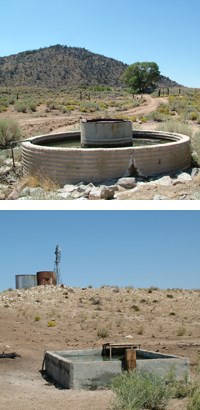
NPS Photo: Kelley Stewart Do mule deer in Mojave National Preserve need more water? It may seem like a silly question. After all, it’s a desert—doesn’t everything need more water? Scientists at Mojave National Preserve are working with the California Department of Fish & Game (CDFG) and researchers at the University of Nevada-Reno to answer this question, and a few others. 
NPS Photos: D. Hughson Seeps, Springs, & Stock Tanks The second part of the project focuses on learning more about the behavior of Mojave’s mule deer. For starters, no one knows for sure how the population size is changing. Deer have been hunted in the area since 1958. Since Mojave National Preserve was established in 1994, the average annual buck harvest has increased 50 percent, from 28 to 42 bucks per year. But buck harvest information alone is not a reliable indicator of mule deer population levels. In addition to springs, there are also stock tanks fed by wells throughout the preserve, principally (and historically) used for watering cattle. It’s not known which of these water sources deer used regularly, or whether they depend upon such artificial water sources of survival. Furthermore, is it water availability that limits the number of deer, or is it something else, such as food availability or predators? 
NPS Photo: Kelley Stewart Where the Mule Deer Roam Then, the mule deer were released into the wild, adorned with new accessories: two identifying ear tags and a VHF high-frequency radio collar. Some deer were also outfitted with an additional collar containing a GPS unit. After 375 days, the GPS collars automatically fall off. Analysis of the device offers researchers “hoof-by-hoof” intelligence on where the deer roam. 
NPS Photo Over the next several years, University of Nevada-Reno graduate students and National Park Service employees will monitor their movements several times a week. Cameras installed at springs throughout the preserve will also capture individual deer movement. When a doe stops for a drink, the camera photographs an image of her numbered “earring.” Mule Deer Management: It Affects Us All To learn more about the legislative and management history behind this research and/or to review technical documents, click here. |
Last updated: February 28, 2015
